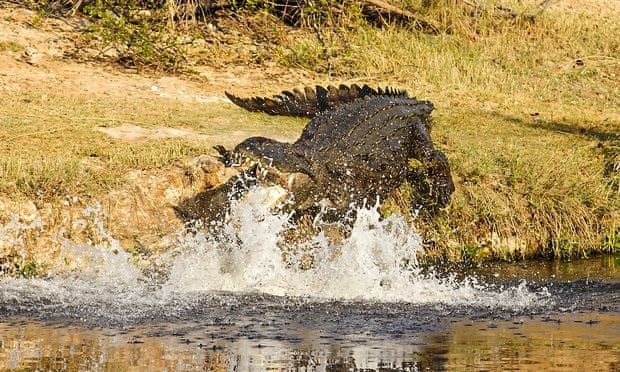Deep in the swampy forests of West Africa, lies the dwarf crocodile, a
miniature version of their large crocodile relatives. The crocodiles are so tiny
they are not hunted for their skin, but for food. This has resulted in fewer of
them remaining in their natural habitat. Will they become extinct?
Living in both terrestrial and freshwater ecosystems, the West African dwarf
crocodile is five and a half to six feet in length. Built more like a smaller
version of crocodiles of normal size, they are darker in color with a yellowish
belly. Black patches cover their reptilian bodies, from the end of their tails
to the blunt snout. The baby dwarf crocs are lighter brown with patterns
sprawled out over the head.
These compact crocs consume fish, crustaceans and frogs, however, they will
make meals of terrestrial animals, such as mice. Food sources will change with
the seasons depending on the abundance of the various edible creatures. During
the dryer season of Africa, they can be seen scooting around on land, searching
for their next meal. The crocs fall under the category of carnivores.
As with the larger crocodile relatives, the dwarf crocodile has impressive
jaw power to slam down on their prey with a powerful force, although they cannot
bite off pieces and chew their prey. The jaw is set up for eating in larger
amounts at one time, without the smaller jaw motions to consume the tinier
bites. The side-to-side motion doesn't exist, although the powerful up and down
movements seem to feed the crocodiles just fine.
Pulling clumps of rotting vegetation into a pile during the wetter season,
the mother dwarf crocodile creates a compost heap, which works as an incubator
to supply the eggs with warmth. One time a year, the female will breed, laying
10 to 20 eggs at a time. The mother guards the nest viciously until the hatching
begins after a period of 85-105 days.
When the babies hatch, their mother escorts them into the water, ensuring
their safety. Some babies may even stay with their mother for a period of a few
weeks. Baby crocs stay in touch with their mom, even though she allows them the
freedom to leave. From a distance, a strange twangy sound can be heard from the
baby crocodiles. This sound is a form of communication from the tiny crocodiles,
apparently to keep their mother informed of their location.
The
African dwarf crocodile stay in shallower swamp waters, however they can
swim quite well. They rely strictly on their tails for power, as do the larger
crocodiles. Walking and even galloping on land is no problem for the crocs, to
maintain speed even on dry ground. The dwarf crocodile is a solitary animal.
Other reptiles have two chambers in the heart while crocodiles have four.
Remaining in the burrows during the daylight hours, the smaller crocs come out
to eat at night.
They hunt in the water, sliding along the banks in search for food. When the
dry season rolls around, at least for the crocs living in the savanna areas,
spending longer amounts of time in the burrows is common.
The dwarf crocodile species is vulnerable to changes in habitat and to the
hunting habits of man. The crocs are often killed for food and due to this, they
are categorized as a vulnerable species in the wild. In some places, the crocs
are more abundant and higher in numbers, however they are diminishing in numbers
in regions such as Gambia. Breeding programs exist in zoos to push the numbers
of this species back up into safer numbers.
The International Union for Conservation of Nature lists the dwarf crocodile
as "vulnerable". The population is decreasing, showing an obvious threat of
extinction in Gambia and Liberia because of the hunting activities of local
residents and the habitat destruction of the area. The smaller size makes the
crocodile an easy target, along with the non-aggressive nature of the
crocodiles, they are easier to capture and transport.
The international trade of the species is controlled and captive breeding is
considered to keep the species at full numbers. Monitoring systems are being
created at high priority status to clearly record the status of the West African
dwarf crocodile as well.








